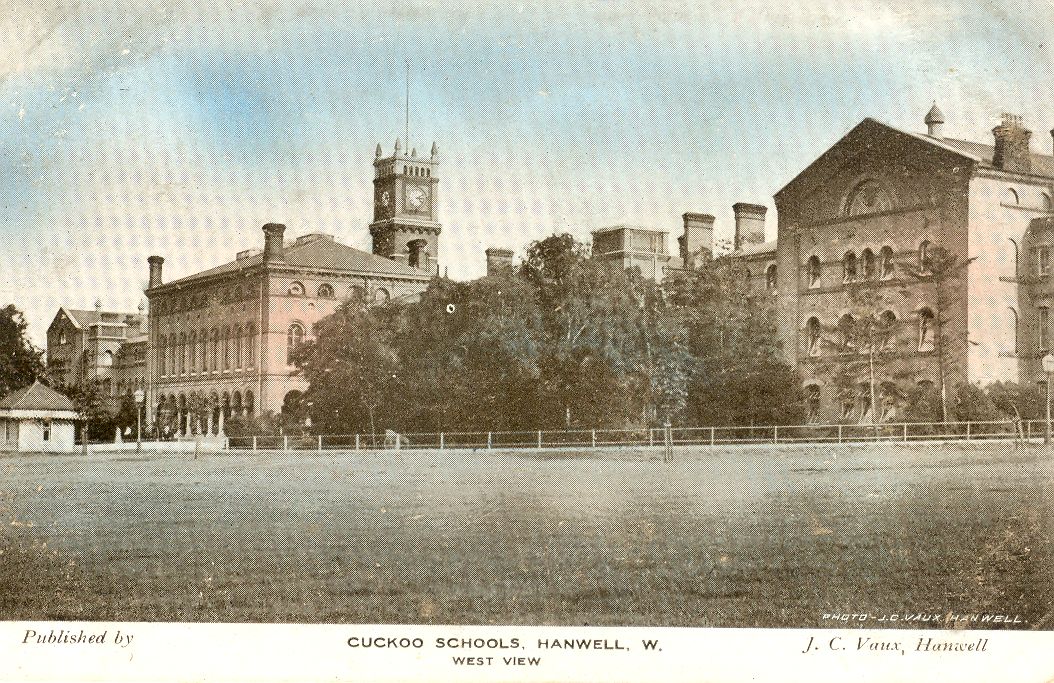One of the most interesting connections with the Hanwell Community Centre is that Charlie Chaplin resided there for a period when it was a school. On a brief visit there last year with Big Dave, I was saddened to see that his statute had been vandalised. However, the good news was that after a lengthy campaign, the historic Centre was eventually saved from demolition. I wanted to know more of course and after some research, came across Peter Higginbotham ‘s two websites on workhouses.
There were details of Chaplin’s time there when it was known as the Central London District School. I then contacted him and asked for permission to reproduce it which he kindly did. His main website address is at: www.workhouses.org.uk and the direct link to the Hanwell page with some superb images can be found at: www.workhouses.org.uk/CentralLondonSD. These are highly recommended and well worth a visit.

Charles Spencer Chaplin was born in Walworth, London, on April 16, 1889, the son of two music hall performers, Charles and Hannah Chaplin. His parents separated before he was five years old. His mother struggled to make a living despite help from young Charlie who first appeared on stage at the age of five. In 1896, seven-year old Charlie briefly became an inmate of the Lambeth Union workhouse, together with his mother, Hannah and his older half-brother Sydney. They went through the usual admission procedure of being separated from their mother, the children having their hair cut short and the workhouse uniform replacing their own clothes which were steamed and put into storage.
In June 1896, after three weeks at the Lambeth workhouse, the two children were then transferred to the Central London District School at Hanwell. They were transferred to the school in a horse-drawn bakery van and spent time in the ‘approbation’ ward and were then separated with Charlie going to the infants’ section and Sydney to the main school. In his autobiography Chaplin recalls that on Saturday afternoon, the bath-house was reserved for the infants who were bathed by older girls, he suffered the ignominy of receiving an all-over wash with a face-cloth from a fourteen year-old.
On reaching the age of seven, he moved to the older boys’ department. He recounts the story of a boy of fourteen trying to escape from the school by climbing on to the roof and defying staff by throwing missiles and horse-chestnuts at them as they climbed after him. For such offences there were regular Friday morning punishment sessions in the gymnasium where all the boys lined up on three sides of a square. For minor offences, a boy was laid face down across a long desk, feet strapped, while his shirt was pulled out over his head. Captain Hindrum, a retired Navy man, then gave him from three to six hefty strokes with a four-foot cane. Recipients would cry appallingly or even faint and afterwards had to be carried away to recover. For more serious offences, birch was used – after three strokes, a boy needed to be taken to the surgery for treatment. Chaplin himself once received three strokes with the cane, apparently for an offence he did not commit.
Two months later, the children were returned to the workhouse where they were met at the gate by Hannah, dressed in her own clothes. In desperation to see them, she had discharged herself from the workhouse, along with the children. After a day spent playing in Kennington Park and visiting a coffee-shop, they returned to the workhouse and had to go through the whole admissions procedure once more, with the children again staying there for a probationary period before returning to Hanwell. Sydney, on reaching the age of eleven, left Hanwell to join the training ship ‘Exmouth’. Charlie remained at the school until January 1898. During his remaining time there, he caught ringworm – an infectious disease of the scalp which was common amongst pauper children. Its treatment required the head to be shaved and treated with iodine which made sufferers the subject of ridicule by other boys.
After a brief period back with his mother, Chaplin was sent for a while to the Lambeth Union’s schools at Norwood. However, when Hannah was admitted to the Cane Hill Asylum, both brothers went to live with their father. In 1906, Charlie became a music-hall clown in Fred Karno’s Mumming Birds Company’. With Karno, he visited the USA in 1913 and his act was seen by film producer Mack Sennett who hired Chaplin for his film studio, Keystone. Charlie’s tramp character, which no doubt drew on the experiences of his early life, eventually made him the highest paid actor in Hollywood.
Steve Russell

well done steve good piece ,on the site and charlie ,two weeks ago a questionaire was sent to local resis, to sugest what we would like to see at this site, i suggested a guided tour of the centre as most people wont set foot inside unless its made user friendly .
Is there any connection between this Community centre and the old Hanwell Asylum of the 1960’s?
no mate hanwell asylum is on the uxbridge rd the top doctor at the asylum many years ago was doctor connoly who had a big house which was where lawn gds and myrtle gds is today the small pk known as connoly dell is all that is left of his grounds ,you can do a tour of the asylum for a small fee ,hanwell com,centre grounds use to go down to the uxbridge rd hanwell of which my house is on of coares with many others but the two sites as far as i no are not linked
Thanks for that info Dave
Great piece. I used to do Judo in the Hanwell commuinity center when i was about 9. I also played 5-a-side in the gymnasium, the place used to give me the creeps.
Hello James…The place has a lot of history and Big Dave has written about the spooky experience he had there, which will go up soon mate
Another really interesting piece Steve. Always good to hear about West London history that surrounds our club.
Look forward to Big Daves piece.
Hi Steve
I am a local artist living next door to Hanwell community centre and I am an avid fan of Charlie Chaplin’s work. I am keen to do do a mural about Hanwell old/contemporary in the recently restored Community Centre of which I have a few old photographs.Do you have any ideas of what may be relevant historically about the building from your readers and i would like to restore the Charlie Chaplin sculpture if I could get a sponsor somehow….
Thanks for the helpful website
http://www.simplesite.com/muralpainting